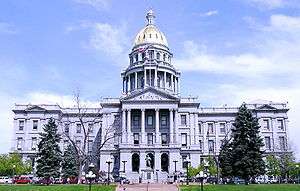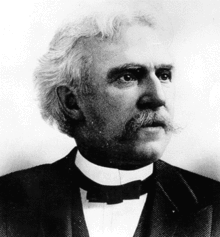Elijah E. Myers
| Elijah E. Myers | |
|---|---|
|
Elijah E. Myers | |
| Born |
December 22, 1832 Philadelphia, Pennsylvania |
| Died |
March 5, 1909 (aged 76) Detroit, Michigan |
| Nationality | American |
| Occupation | Architect |
Elijah E. Myers (December 22, 1832, Philadelphia[1][2] – March 5, 1909, Detroit[2]) was a leading architect of government buildings in the latter half of the 19th century, and the only architect to design the capitol buildings of three U.S. states, the Michigan State Capitol, the Texas State Capitol, and the Colorado State Capitol.[2] He also designed buildings in Mexico and Brazil. Myers' designs favored Victorian Gothic and Neo-Classical styles, but he worked in other styles as well.
Early life
Myers may have studied architecture under Samuel Sloan before serving in the Civil War.[1] He initially lived in Springfield, Illinois after the Civil War, but moved to Detroit, Michigan while working on the Michigan State capitol, where he remained. Myers had conflicts with fellow architects, whom he claimed stole his designs and sued, and sometimes his clients. He was fired from the Texas Capitol project in 1886 over complaints that he was not giving enough attention to the project, and his design was subsequently changed. He was also fired from the Colorado State Capitol project and the Howell Library project, apparently in disputes about money.
In 1879, Myers sued Edwin May, the architect of a new Indiana State House, claiming that elements of design were stolen. Myers lost the lawsuit.
In 1891, Myers applied for the position of Supervising Architect of the U.S. Treasury but another was chosen.
During the Chicago World's Fair in 1893, Myers served on the Board of Examiners for the fair's buildings.[2]
Myers died at home in Detroit and was buried in Woodlawn Cemetery, Detroit. His grave is currently unmarked but an Elijah Myers Memorial Commission is raising funds for an appropriate stone. The only known portrait of Myers hangs in the Elijah Myers room of the Michigan State Capitol.
Post-death litigation
On January 5, 1914, the Supreme Court decided Radford v. Myers in Myers' favor. The cases was a business dispute between Myers and his attorney, George W. Radford, involving litigation about the unbuilt Luzerne County Courthouse.
Works





- design for a Lincoln Memorial, 1868 (unbuilt)
- Macoupin County Courthouse, Carlinville, Illinois, 1870
- Michigan State Capitol, Lansing, Michigan, 1872
- First Presbyterian Church, Albion, Michigan, c. 1873 (burned 1883, but the shell was incorporated in the replacement)
- President's House, Michigan State University, East Lansing, Michigan, 1874 (demolished 1940s)
- Grosvernor House, Jonesville, Michigan, 1874
- Lansing High School, Lansing, Michigan, 1875 (demolished summer 2006)
- Plymouth Congregational Church, 1877 (burned, 1971)
- Eastern Michigan Asylum for the Insane (aka Clinton Valley Center), Pontiac, Michigan, c. 1878 (demolished, 2000)
- Grant County Courthouse, Marion, Indiana, c. 1880 (dome removed)
- Lorain County Courthouse, Elyria, Ohio, c. 1881 - same design as Grant County, Indiana (dome also removed)
- Texas State Capitol, Austin, Texas, 1881
- Harper Hospital, Detroit, Michigan, 1883 (demolished 1970s)
- Knox County Courthouse, Galesburg, Illinois, 1885
- Idaho territorial capitol, c. 1885
- Colorado State Capitol, Denver, Colorado, 1885
- Seneca County Courthouse, Tiffin, Ohio, c. 1886 (demolition started 1/4/2012; to be completed by 2/1/2012) - Live Demo Cam
- (Old) City Hall, Richmond, Virginia, c. 1887
- Central United Methodist Church, Lansing, Michigan, 1888
- Grand Rapids City Hall, Grand Rapids, Michigan, 1888 (demolished 1960s)
- Alumni Hall, Knox College, Galesburg, Illinois, 1890
- San Joaquin County Courthouse, Stockton, California, c. 1891 (demolished 1961)
- Stockbridge Town Hall, Stockbridge, Michigan, 1892
- Columbia Buildings, World's Columbian Exposition, Chicago, Illinois, c. 1890 (demolished)
- asylum, Mexico City, Mexico, ante 1893
- Brazilian Parliament Building, Rio de Janeiro, Brazil, ante 1893 (demolished)[2]
- Luzerne County Courthouse, Wilkes-Barre, Pennsylvania, 1894 (unbuilt)
- Bay City City Hall, Bay City, Michigan, 1897
- Helen Newberry Nurses Home, Detroit, Michigan, 1898[3]
- Howell Carnegie District Library, Howell, Michigan, 1902
- McDonough County Courthouse, Macomb, Illinois
- Stephenson County Courthouse, Freeport, Illinois
- Silverton Miner's Union Hospital 1907, Silverton, Colorado, under restoration 2014
References
- 1 2 "Elijah E. Myers". Michigan's State Capitol: History, Art and Architecture. Michigan Department of Management and Budget (as excerpted by the Michigan Senate). Retrieved 2009-06-02.
- 1 2 3 4 5 "Col. Elijah E. Myers (obituary)" (pdf). The New York Times. March 6, 1909. Retrieved 2009-06-02.
- ↑ "Seven Michigan Properties Added to the National Register of Historic Places," press release, Michigan Department of History, Arts and Libraries (HAL), Aug. 7, 2008
Other sources
- Asylum: Pontiac’s Grand Monument from the Gilded Age, Bruce J. Annett, Jr., ISBN 0-9719141-0-9
- A Michigan Architect in Indiana: Elijah E. Myers and the Business of Architecture in the Gilded Age, Ronald D. Rarick, The Michigan Historical Review Vol. 26, No. 2, Fall 2000
- Elijah E. Myers: Politics, patronage, and professionalism, Paul Goeldner
- The Designing Architect: Elijah E. Myers, Paul Goeldner, Southwestern Historical Quarterly 92 (October 1988)
- Radford v. Myers 231 U.S. 725 (1914)
External links
| Wikimedia Commons has media related to Elijah E. Myers. |
- Elijah E. Myers from the Handbook of Texas Online
- Myers biography, Colorado State website
- construction of the Colorado Capitol, Colorado State website
- Old Richmond City Hall
- photo album of the Eastern Michigan Asylum
- historical marker for Central United Methodist Church
- historical marker for Clinton Valley Center
- historical marker for First Presbyterian Church of Albion
- historical marker for Grosvernor House
- historical marker for Plymouth Congregational Church
- historical marker for Stockbridge Town Hall
- Radford v. Myers
- photos of San Joaquin County courthouses
- postcards of Harper Hospital
- Toledo Blade article on Myers
